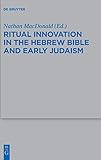Ritual Innovation in the Hebrew Bible and Early Judaism / ed. by Nathan MacDonald.
Material type: TextSeries: Beihefte zur Zeitschrift für die alttestamentliche Wissenschaft ; 468Publisher: Berlin ; Boston : De Gruyter, [2016]Copyright date: ©2016Description: 1 online resource (VIII, 171 p.)Content type:
TextSeries: Beihefte zur Zeitschrift für die alttestamentliche Wissenschaft ; 468Publisher: Berlin ; Boston : De Gruyter, [2016]Copyright date: ©2016Description: 1 online resource (VIII, 171 p.)Content type: - 9783110372731
- 9783110392678
- 9783110368710
- BM700 .R455 2016
- online - DeGruyter
- Issued also in print.
| Item type | Current library | Call number | URL | Status | Notes | Barcode | |
|---|---|---|---|---|---|---|---|
 eBook
eBook
|
Biblioteca "Angelicum" Pont. Univ. S.Tommaso d'Aquino Nuvola online | online - DeGruyter (Browse shelf(Opens below)) | Online access | Not for loan (Accesso limitato) | Accesso per gli utenti autorizzati / Access for authorized users | (dgr)9783110368710 |
Frontmatter -- Preface -- Table of Contents -- Strange Fire before the Lord: Thinking about Ritual Innovation in the Hebrew Bible and Early Judaism -- Two Types of Ritual Innovation for Profit -- From Ark of the Covenant to Torah Scroll: Ritualizing Israel’s Iconic Texts -- The Empty Throne and the Empty Sanctuary: From Aniconism to the Invisibility of God in Second Temple Theology -- Ritual Innovation and Shavuʿot -- How the Priestly Sabbaths Work: Innovation in Pentateuchal Priestly Ritual -- Innovation in the Suspected Adulteress Ritual (Num 5:11–31) -- Practicing Rituals in a Textual World: Ritual and Innovation in the Book of Numbers -- Walking over the Dead: Burial Practices and the Possibility of Ritual Innovation at Qumran -- Contributors -- Subject Index -- Index of names
restricted access online access with authorization star
http://purl.org/coar/access_right/c_16ec
Are the rituals in the Hebrew Bible of great antiquity, practiced unchanged from earliest times, or are they the products of later innovators? The canonical text is clear: ritual innovation is repudiated as when Jeroboam I of Israel inaugurate a novel cult at Bethel and Dan. Most rituals are traced back to Moses. From Julius Wellhausen to Jacob Milgrom, this issue has divided critical scholarship. With the rich documentation from the late Second Temple period, such as the Dead Sea Scrolls, it is apparent that rituals were changed. Were such rituals practiced, or were they forms of textual imagination? How do rituals change and how are such changes authorized? Do textual innovation and ritual innovation relate? What light might ritual changes between the Hebrew Bible and late Second Temple texts shed on the history of ritual in the Hebrew Bible? The essays in this volume engage the various issues that arise when rituals are considered as practices that may be invented and subject to change. A number of essays examine how biblical texts show evidence of changing ritual practices, some use textual change to discuss related changes in ritual practice, while others discuss evidence for ritual change from material culture.
Issued also in print.
Mode of access: Internet via World Wide Web.
In English.
Description based on online resource; title from PDF title page (publisher's Web site, viewed 28. Feb 2023)


